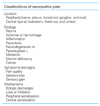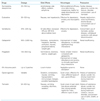Abstract
Neuropathic pain has recently been defined as "pain arising as a direct consequence of a lesion or disease affecting the somatosensory system". Neuropathic pain is a debilitating chronic condition that remains very difficult to treat and challenging to manage. Tricyclic antidepressants (amitryptiline, nortriptyline, imipramine), selective serotonin and norepinephrine reuptake inhibitors (duloxetine, venlafaxine), anticonvulsants (gabapentin, pregabalin), and 5% lidocaine patches have demonstrated efficacy in neuropathic pain and are recommended as first-line medications. In patients who fail to respond to these first-line medications alone and/or in combination, opioid analgesics or tramadol can be used as a second-line treatment alone or in combination with one of the first-line medications. Opioid analgesics and tramadol can also be considered for first-line use in selected clinical circumstances. Other pharmacological therapeutic options include selective serotonin reuptake inhibitors, antiepileptic drugs (levetiracetam, lacosamide, lamotrigine, valproic acid), cannabinoids, high concentration capsaicin patch, and botulinum toxin A. Medication selection should be individualized, with side effects taken into consideration as well as potential beneficial or deleterious effects on comorbidities, and whether or not prompt onset of pain relief is necessary.
Figures and Tables
References
1. Treede RD, Jensen TS, Campbell JN, Cruccu G, Dostrovsky JO, Griffin JW, Hansson P, Hughes R, Nurmikko T, Serra J. Neuropathic pain: redefinition and a grading system for clinical and research purposes. Neurology. 2008. 70:1630–1635.

2. Bouhassira D, Lanteri-Minet M, Attal N, Laurent B, Touboul C. Prevalence of chronic pain with neuropathic characteristics in the general population. Pain. 2008. 136:380–387.

3. Freynhagen R, Baron R, Gockel U, Tolle TR. painDETECT: a new screening questionnaire to identify neuropathic components in patients with back pain. Curr Med Res Opin. 2006. 22:1911–1920.

4. Roose SP, Laghrissi-Thode F, Kennedy JS, Nelson JC, Bigger JT, Pollock BG, Gaffney A, Narayan M, Finkel MS, McCafferty J, Gergel I. Comparison of paroxetine and nortriptyline in depressed patients with ischemic heart disease. JAMA. 1998. 279:287–291.

5. Ray WA, Meredith S, Thapa PB, Hall K, Murray KT. Cyclic antidepressants and the risk of sudden cardiac death. Clin Pharmacol Ther. 2004. 75:234–241.

6. Finnerup NB, Sindrup SH, Jensen TS. The evidence for pharmacological treatment of neuropathic pain. Pain. 2010. 150:573–581.

7. Rowbotham MC, Goli V, Kunz NR, Lei D. Venlafaxine extended release in the treatment of painful diabetic neuropathy: a double-blind, placebo-controlled study. Pain. 2004. 110:697–706.

8. Shaikh S, Yaacob HB, Abd Rahman RB. Lamotrigine for trigeminal neuralgia: efficacy and safety in comparison with carbamazepine. J Chin Med Assoc. 2011. 74:243–249.

9. Johannessen CU. Mechanisms of action of valproate: a commentatory. Neurochem Int. 2000. 37:103–110.

10. Finnerup NB, Grydehoj J, Bing J, Johannesen IL, Biering-Sorensen F, Sindrup SH, Jensen TS. Levetiracetam in spinal cord injury pain: a randomized controlled trial. Spinal Cord. 2009. 47:861–867.

11. Wymer JP, Simpson J, Sen D, Bongardt S. Lacosamide SP742 Study Group. Efficacy and safety of lacosamide in diabetic neuropathic pain: an 18-week double-blind placebo-controlled trial of fixed-dose regimens. Clin J Pain. 2009. 25:376–385.
12. Dworkin RH, O'Connor AB, Backonja M, Farrar JT, Finnerup NB, Jensen TS, Kalso EA, Loeser JD, Miaskowski C, Nurmikko TJ, Portenoy RK, Rice AS, Stacey BR, Treede RD, Turk DC, Wallace MS. Pharmacologic management of neuropathic pain: evidence-based recommendations. Pain. 2007. 132:237–251.

13. Wu CL, Agarwal S, Tella PK, Klick B, Clark MR, Haythornthwaite JA, Max MB, Raja SN. Morphine versus mexiletine for treatment of postamputation pain: a randomized, placebo-controlled, crossover trial. Anesthesiology. 2008. 109:289–296.
14. Attal N, Cruccu G, Baron R, Haanpaa M, Hansson P, Jensen TS, Nurmikko T. European Federation of Neurological Societies. EFNS guidelines on the pharmacological treatment of neuropathic pain: 2010 revision. Eur J Neurol. 2010. 17:1113–1123. e67–e88.

15. Benedetti F, Vighetti S, Amanzio M, Casadio C, Oliaro A, Bergamasco B, Maggi G. Dose-response relationship of opioids in nociceptive and neuropathic postoperative pain. Pain. 1998. 74:205–211.

16. Finnerup NB, Otto M, McQuay HJ, Jensen TS, Sindrup SH. Algorithm for neuropathic pain treatment: an evidence based proposal. Pain. 2005. 118:289–305.

17. Wong GY, Gavva NR. Therapeutic potential of vanilloid receptor TRPV1 agonists and antagonists as analgesics: recent advances and setbacks. Brain Res Rev. 2009. 60:267–277.

18. Backonja M, Wallace MS, Blonsky ER, Cutler BJ, Malan P Jr, Rauck R, Tobias J. NGX-4010 C116 Study Group. NGX-4010, a high-concentration capsaicin patch, for the treatment of postherpetic neuralgia: a randomised, double-blind study. Lancet Neurol. 2008. 7:1106–1112.

19. Simpson DM, Brown S, Tobias J;. NGX-4010 C107 Study Group. Controlled trial of high-concentration capsaicin patch for treatment of painful HIV neuropathy. Neurology. 2008. 70:2305–2313.

21. Aoki KR. Review of a proposed mechanism for the antinociceptive action of botulinum toxin type A. Neurotoxicology. 2005. 26:785–793.

22. Ranoux D, Attal N, Morain F, Bouhassira D. Botulinum toxin type A induces direct analgesic effects in chronic neuropathic pain. Ann Neurol. 2008. 64:274–283.

23. Yuan RY, Sheu JJ, Yu JM, Chen WT, Tseng IJ, Chang HH, Hu CJ. Botulinum toxin for diabetic neuropathic pain: a randomized double-blind crossover trial. Neurology. 2009. 72:1473–1478.

24. Dworkin RH, O'Connor AB, Audette J, Baron R, Gourlay GK, Haanpaa ML, Kent JL, Krane EJ, Lebel AA, Levy RM, Mackey SC, Mayer J, Miaskowski C, Raja SN, Rice AS, Schmader KE, Stacey B, Stanos S, Treede RD, Turk DC, Walco GA, Wells CD. Recommendations for the pharmacological management of neuropathic pain: an overview and literature update. Mayo Clin Proc. 2010. 85:3 Suppl. S3–S14.

25. Jo HR, Chae YK, Kim YH, Chai HS, Lee WK, Choi SS, Min JH, Choi IG, Choi YS. Remifentanil-induced pronociceptive effect and its prevention with pregabalin. Korean J Anesthesiol. 2011. 60:198–204.

26. Gilron I, Bailey JM, Tu D, Holden RR, Jackson AC, Houlden RL. Nortriptyline and gabapentin, alone and in combination for neuropathic pain: a double-blind, randomised controlled crossover trial. Lancet. 2009. 374:1252–1261.

27. Hanna M, O'Brien C, Wilson MC. Prolonged-release oxycodone enhances the effects of existing gabapentin therapy in painful diabetic neuropathy patients. Eur J Pain. 2008. 12:804–813.

28. Arai YC, Matsubara T, Shimo K, Suetomi K, Nishihara M, Ushida T, Kobayashi K, Suzuki C, Kinoshita A, Kondo M, Matsubara S, Hayashi R, Tohyama Y, Nishida K, Arakawa M. Low-dose gabapentin as useful adjuvant to opioids for neuropathic cancer pain when combined with low-dose imipramine. J Anesth. 2010. 24:407–410.





 PDF
PDF ePub
ePub Citation
Citation Print
Print




 XML Download
XML Download